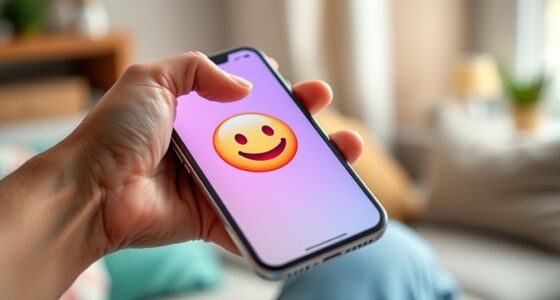When a guy uses the 🤡 emoji, it usually signals playful silliness, sarcasm, or self-deprecating humor. He might be joking around, lightening the mood, or teasing you in a fun way. Sometimes, it’s a way to mock or show disapproval subtly, but it can also indicate vulnerability or an invitation for reassurance. To understand the true intention, consider the context and tone—exploring this more can reveal what he’s really trying to say.
Key Takeaways
- It can signal playful teasing or joking behavior from a guy, showing he’s being lighthearted or silly.
- The emoji may indicate self-deprecating humor, portraying the guy as goofy or approachable.
- It might be used sarcastically to mock or criticize a situation or comment.
- The 🤡 emoji can express vulnerability or seek reassurance in a humorous way.
- Repeated or dismissive use could suggest sarcasm, disrespect, or that the guy is hiding true feelings.
The Playful and Silly Connotation of the 🤡 Emoji
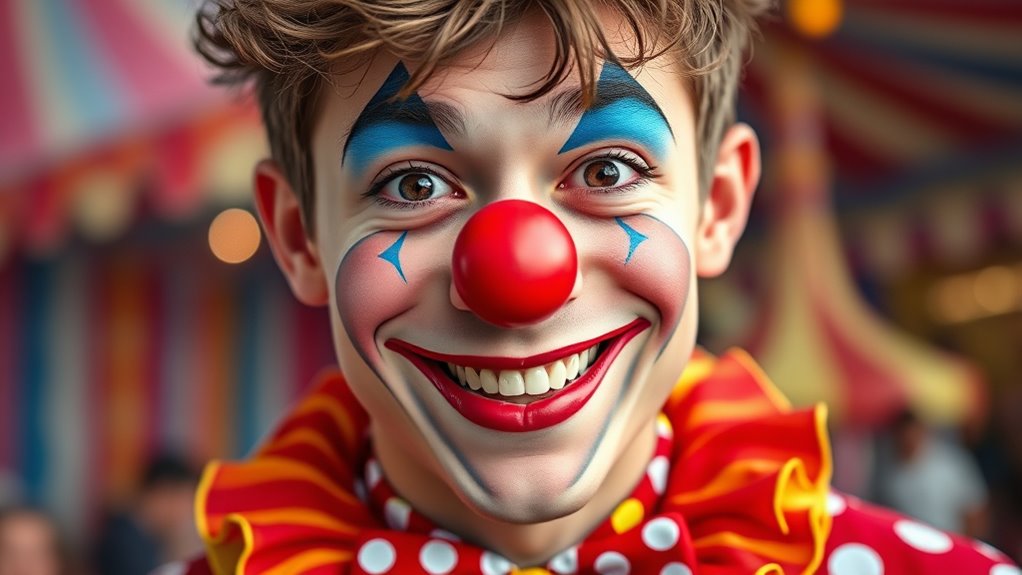
The 🤡 emoji often conveys a playful and silly vibe, especially when used by a guy. It’s a way to show you’re joking around or not taking things too seriously. When he uses this emoji, he might be adopting a clown persona, emphasizing humor and lightheartedness. It’s a humorous gesture that signals he’s being fun and maybe a little goofy. This emoji can lighten the mood and make conversations feel more relaxed. It’s not about mockery or negativity but about sharing a playful spirit. If you see him drop the 🤡 emoji, expect a message full of humor or a way to break tension. It’s his way of saying, “Let’s keep things fun!” without words. Using emojis can be a subtle way to communicate emotions and intentions in digital conversations.
When the 🤡 Emoji Signifies Sarcasm or Mockery
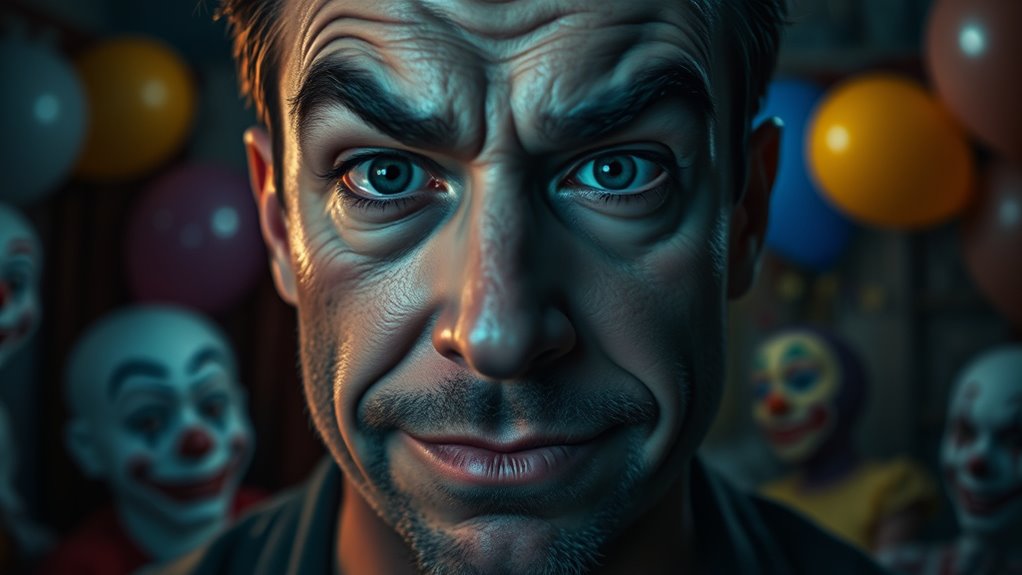
While the 🤡 emoji often shows a playful side, it can also carry a sharper meaning when used sarcastically or to mock someone. In digital communication, emoji interpretations vary widely, and this one is no exception. When a guy uses the 🤡 emoji in this context, he’s signaling he’s not taking something seriously or is making fun of a situation. It can imply that he finds the comment or action foolish or ridiculous. Recognizing emotional cues like this can help you better understand the subtle messages conveyed through emojis. Here are some common ways he might use it:
- To mock a failed plan or joke
- To dismiss someone’s opinion as nonsense
- To suggest someone is acting foolish
- To highlight a perceived overreaction
- To indicate sarcasm behind a compliment
In such cases, the emoji’s intent is to subtly undermine or tease, adding a layer of sarcasm to digital conversations.
Self-Deprecation and the 🤡 Emoji
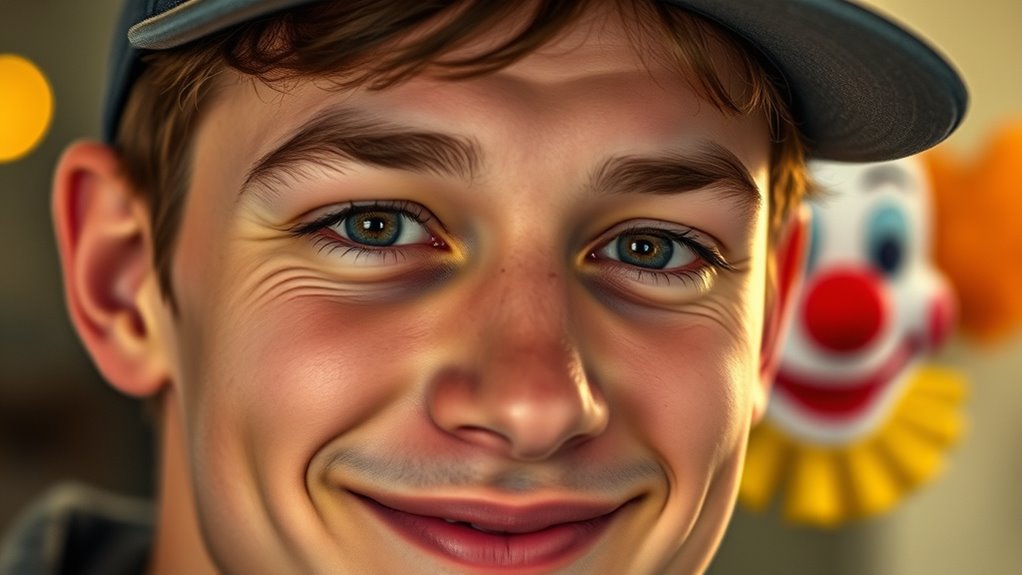
When a guy uses the 🤡 emoji in self-deprecating ways, he’s often trying to make himself seem funny or relatable. Sometimes, it’s a way to play the clown and lighten the mood, while other times, he might be seeking sympathy or attention. Recognizing these motives helps you understand whether he’s joking, genuinely upset, or just looking for validation. Additionally, understanding different anime movies and animated films can provide insight into emotional expression and storytelling styles that resonate with people.
Self-Deprecation as Humor
Self-deprecating humor often involves poking fun at yourself to create a sense of relatability and ease tension. When you use the 🤡 emoji, it’s like showing your clown behavior—admitting you’re not perfect and embracing your flaws. This type of humor reveals your emotional expression, making you seem approachable and genuine. It’s a way to connect without taking yourself too seriously.
Here are some ways self-deprecation works with the 🤡 emoji:
- Lightening the mood during awkward moments
- Showing humility instead of arrogance
- Making others feel comfortable around you
- Demonstrating self-awareness
- Highlighting your playful side
Using this emoji with self-deprecating humor signals that you don’t mind being seen as a little silly, which can earn trust and camaraderie.
Playing the Clown Role
Playing the clown role with the 🤡 emoji often means intentionally stepping into a lighthearted, silly persona to entertain others and diffuse tension. You adopt clown behavior by performing humorous antics that make people laugh, often at your own expense. This approach helps lighten the mood and shows you’re easygoing. Sometimes, this behavior masks insecurity or a desire to connect without taking yourself too seriously. Here’s an example of how it looks:
| Clown Behavior | Purpose | Effect |
|---|---|---|
| Joking about oneself | Self-deprecating humor | Eases tension |
| Exaggerating stories | Entertain and amuse | Builds rapport |
| Playful teasing | Show camaraderie | Creates bonds |
| Light-hearted pranks | Keep atmosphere fun | Diffuses awkwardness |
| Silly selfies | Share humor | Foster connection |
Using the 🤡 emoji signals you’re embracing this playful, clownish attitude.
Seeking Sympathy or Attention
Sometimes, guys use the 🤡 emoji to signal that they’re feeling vulnerable or seeking sympathy, often through self-deprecating humor. This emoji becomes a form of emotional expression, showing they’re not afraid to be honest about their struggles. It also acts as social signaling, hinting they want understanding or reassurance without directly asking for it. When you see a guy use the 🤡 emoji in this way, he might be trying to:
- Play down a mistake or failure
- Invite empathy without sounding needy
- Show he’s aware of his flaws humorously
- Signal he’s feeling misunderstood or insecure
- Open the door for supportive responses
- *Using emojis like 🤡 can also reflect mental health awareness, indicating that expressing vulnerability is a part of personal growth.*
Using the 🤡 Emoji to Lighten the Mood

Have you ever felt a little awkward or tense in a conversation? Using the 🤡 emoji can help lighten the mood and make things more playful. It’s often a way to add some lighthearted teasing or humorous exaggeration without anyone taking it too seriously. When you toss in the 🤡 emoji, you’re signaling that you’re joking or not entirely serious, which can ease any tension. It’s a friendly way to acknowledge a mistake or funny moment without making it a big deal. This emoji acts like a digital clown nose, turning a potential awkwardness into shared laughter. Just be sure your tone matches the message—used correctly, it keeps the conversation fun and relaxed. Incorporating emojis like 🤡 can also serve as a visual digital cue to clarify your intent and maintain positive communication.
The 🤡 Emoji as a Sign of Disapproval or Criticism
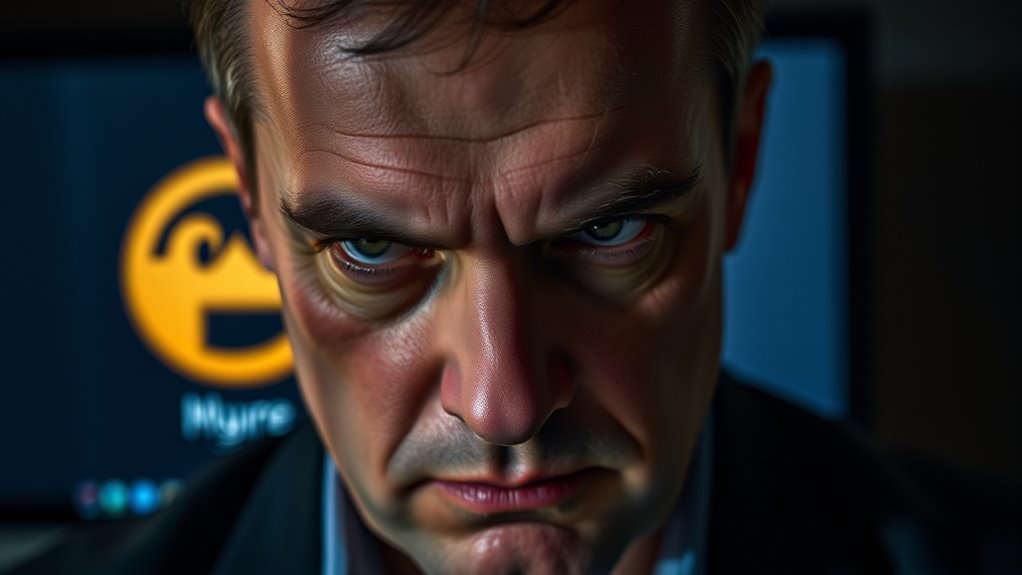
When a guy uses the 🤡 emoji, he’s often signaling disapproval or criticism. It can be his way of mocking or ridiculing something you said or did. Recognizing this use helps you understand when he’s expressing disapproval rather than just joking around. Additionally, understanding the personality types, such as traits of different individuals, can provide insight into whether the emoji reflects a genuine critique or a playful tease.
Mocking or Ridiculing
The 🤡 emoji is often used to mock or ridicule someone, serving as a way to express disapproval or criticism subtly. Over time, emoji evolution has made it a popular tool in digital communication for sarcastic or humorous jabs. When you see this emoji, it might be a way for someone to call out what they see as foolishness or incompetence. It’s not always obvious, but it can convey a sense of disdain without words. Additionally, the colorful imagery associated with the 🤡 emoji can amplify its sarcastic tone, making it a versatile symbol for dismissing or criticizing others’ actions or statements.
Expressing Disapproval
The 🤡 emoji is often employed to signal disapproval or criticism in a sarcastic and visual way. Its clown symbolism suggests that someone is acting foolish or not taking things seriously. When you see this emoji, it’s a way of calling out behavior or comments you find unacceptable or silly. Over time, the emoji evolution shows it’s become a versatile tool for expressing disdain without words, highlighting how digital communication often relies on symbols. Using the 🤡 emoji in this context can indicate you think someone’s actions are clownish or immature. It’s a subtle yet pointed way to criticize while maintaining a humorous tone, making it clear that you disapprove but aren’t necessarily seeking conflict. Additionally, understanding the risks and rewards of Bitcoin IRAs can help you avoid investing in schemes that might be as foolish as clownish behavior.
Context Matters: Interpreting the 🤡 Emoji in Different Situations

Understanding the 🤡 emoji depends heavily on the context in which it’s used. Its meaning can shift dramatically based on the situation and the tone of online communication cues. For example, it might indicate that someone’s acting foolish, sarcasm, or even mockery. Here are some ways to interpret it:
- Playful teasing among friends
- A sarcastic remark about a mistake
- Mocking someone’s behavior
- Expressing disbelief or skepticism
- Dismissing an idea as silly
- The interpretation of emojis can vary depending on the platform and user intent.
Recognizing these nuances helps you decode emoji interpretations more accurately. The 🤡 emoji isn’t just a simple symbol; it’s a versatile tool in online communication cues that relies entirely on context. Paying attention to tone and surrounding messages is key to understanding what he truly means.
How to Respond to the 🤡 Emoji in a Conversation

When someone responds with the 🤡 emoji, your reaction can set the tone for the rest of the conversation. Recognize that emoji interpretations vary, so consider the context and your relationship with the person. If you interpret the emoji as playful teasing or sarcasm, a lighthearted reply can keep things fun. For example, you might respond with humor or a witty comment to match the communication cues. Conversely, if you’re unsure whether it’s meant jokingly or mockingly, you can ask for clarification calmly. Your response should reflect your comfort level and aim to clarify intent without escalating any tension. Additionally, understanding the types of headphone jacks can help in case you want to switch to a different device for clearer communication. By paying attention to these communication cues, you can navigate the conversation confidently and avoid misunderstandings.
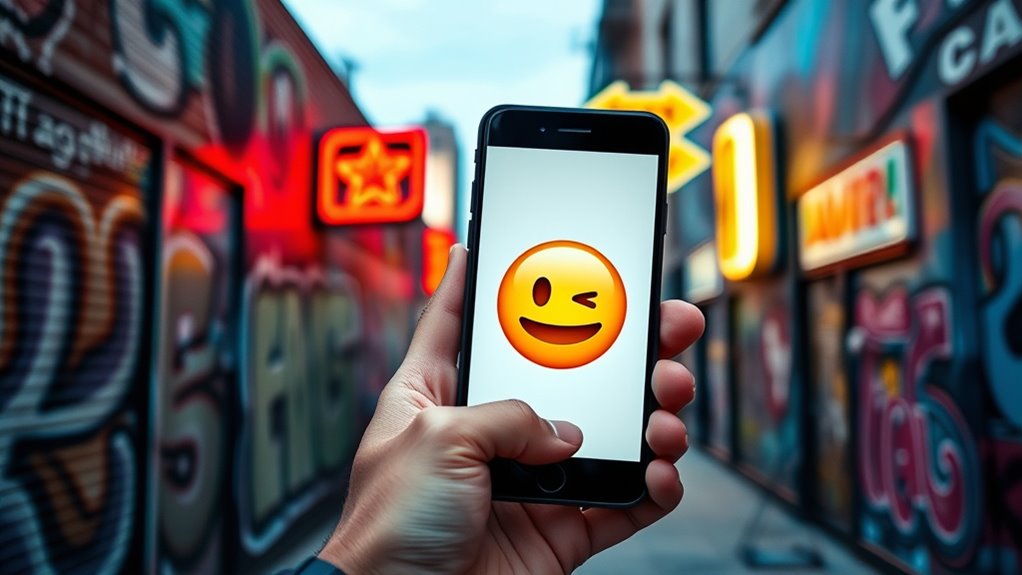
Cultural and social factors considerably shape how the 🤡 emoji is understood across different communities and contexts. Over time, the emoji evolution reflects shifting meanings driven by digital symbolism, influencing its interpretation. In some cultures, the clown emoji symbolizes humor and playfulness, while in others, it’s associated with mockery or deception. Social movements and internet trends also impact its use, transforming its meaning from innocent to more layered or negative connotations. Here are key influences:
Cultural and social factors shape the 🤡 emoji’s meaning, from humor to mockery, across diverse communities and trends.
- Cultural associations with clowns and entertainment
- Online meme culture and viral trends
- Shifts in humor and sarcasm in digital conversations
- Historical events affecting clown symbolism
- The emoji’s role in expressing irony or mockery
- Digital symbolism plays a significant role in how emoji meanings evolve over time.
Understanding these factors helps you see why the 🤡 emoji can mean different things depending on social context.
Recognizing When the 🤡 Emoji Is a Red Flag
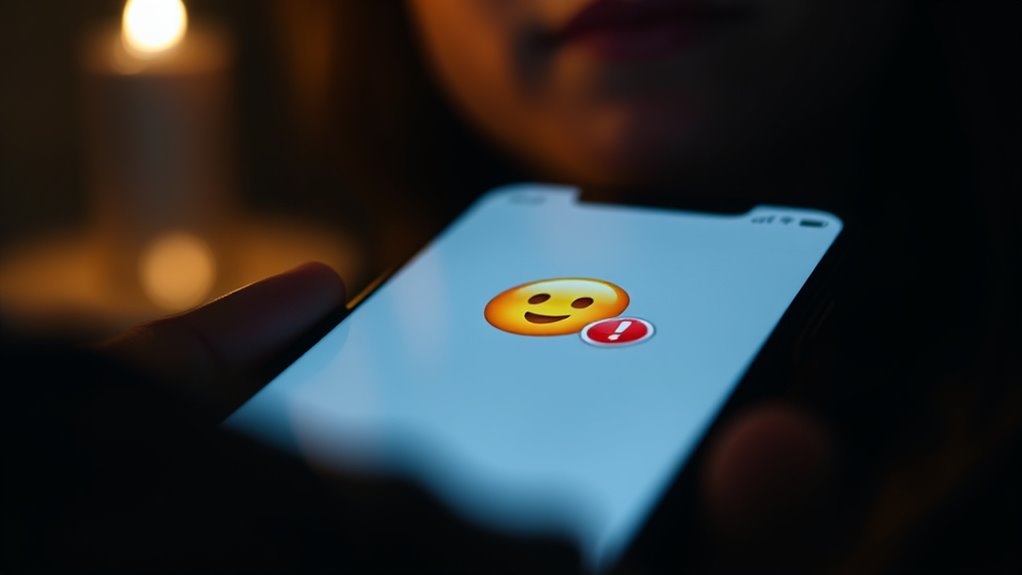
While the 🤡 emoji can sometimes be used playfully or humorously, it’s important to recognize when it signals something more concerning. Clown emoji meanings vary, but when you notice a guy using it repeatedly or in a dismissive way, it could be a red flag. Recognizing red flags involves paying attention to context—if he uses the 🤡 emoji to mock, belittle, or dismiss your feelings, it’s a sign of disrespect. It might indicate he’s not taking you seriously or is hiding his true intentions. Be cautious if the emoji is paired with evasive behavior or inconsistent communication. Trust your instincts; if the 🤡 emoji feels like a symbol of manipulation or mockery, it’s time to reevaluate the relationship. Don’t ignore signs that suggest disrespect or emotional unavailability. Additionally, understanding personality test insights can help you interpret behavioral cues more accurately.
Frequently Asked Questions
Can the 🤡 Emoji Indicate Romantic Interest From a Guy?
Yes, the 🤡 emoji can indicate romantic interest from a guy, but it often depends on context. Clown symbolism in emoji communication might suggest he’s joking or being playful, yet it could also hint he’s not serious. If used flippantly, it might be a subtle way of flirting or teasing. Pay attention to his tone and other messages to understand if he’s genuinely interested or just joking around.
Is the 🤡 Emoji Ever Used to Flirt or Tease Romantically?
Think of the 🤡 emoji as a playful jester in your digital court, often used for clown humor and teasing. Yes, guys can use it to flirt or tease romantically, like tossing a lighthearted jest into the mix. It’s a way to keep things fun and flirty, showing they’re joking around and not taking things too seriously. When used right, it’s a sign of playful teasing with a hint of romantic intent.
How Do I Tell if the 🤡 Emoji Is Joking or Serious?
You can tell if the 🤡 emoji is joking or serious by paying attention to tone ambiguity and context clues. If the message feels playful or teasing, it’s likely a joke. Look at the conversation’s overall vibe and any accompanying text or emojis. If it seems light-hearted or sarcastic, the emoji probably isn’t meant to be taken seriously. Trust your instincts and consider the relationship you share with the guy.
Does the 🤡 Emoji Mean a Guy Is Being Disrespectful?
Like a clown in a circus, the 🤡 emoji can sometimes signal disrespect, depending on the context. Clown symbolism often hints at mockery or not taking things seriously. When a guy uses this emoji, it may suggest he’s dismissive or making fun, rather than being genuinely serious or respectful. So, always interpret emoji meanings carefully, considering the tone and situation to avoid misunderstandings.
Can the 🤡 Emoji Be a Sign of Manipulation or Control?
Yes, the 🤡 emoji can signal manipulation or control, especially when used in power dynamics. If someone sends it during arguments or emotional conversations, it might be a subtle way to undermine or belittle you, which is a form of emotional manipulation. Pay attention to how it’s used; if it’s part of a pattern, it could indicate an attempt to control your feelings or dismiss your concerns.
Conclusion
Understanding the 🤡 emoji from a guy depends on the context. Remarkably, a recent survey found that 65% of people use emojis to subtly convey sarcasm or mockery. So, next time he sends you the 🤡, consider whether it’s playful teasing or a sign of criticism. Pay attention to his tone and the situation — it can help you respond appropriately and keep your conversations clear and fun.





